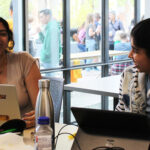
ASU engineers, scientists set stage to expand sensor research
November 29, 2007
Imagine getting a phone call informing you that you are about to get sick even before you start to feel any symptoms of illness. The rapid development of sensor technology — including biosensor devices — is making such a scenario increasingly possible.
As many as 150 ASU researchers are working with sensor technology. But many remain unaware of the sensor work their colleagues are involved in, says Mark Hayes, a chemistry and biochemistry professor in the College of Liberal Arts and Sciences.
Concerned that the lack of communication could slow progress on promising advances, Hayes helped organize ASU’s first Sensor Symposium recently to encourage research partnerships.
“The main thing we did was make connections that will allow researchers to collaborate and contribute to projects,” he says.
Sensor research spans not only every aspect of engineering — particularly bioengineering — but other areas such as physics and health care sciences. Researchers say the technology also has the potential to help meet global environmental and economic challenges.
“The area of sensors and biosensors is so interdisciplinary,” says Bruce Towe, a professor in the Harrington Department of Bioengineering in the Ira A. Fulton School of Engineering. “By the time you end up with all of these various fields of expertise necessary to develop just one sensor device, you have included most of the science and engineering departments.”
The October 26 symposium brought together 120 people interested in sensor research, from faculty and students to representatives from the National Science Foundation, national laboratories and industry.
Towe knows how important it is to partner with granting agencies and industry professionals. He has received grant funding from the National Aeronautics and Space Administration for almost a decade to develop a sensor that will monitor the physical conditions of astronauts in space. The sensors enable NASA scientists to understand what’s happening to the astronauts’ bodies, right down to the molecular level.
“Think about the breadth of activity that sensors encompass. We’re going from sensors that we’re putting in space to sensors that you can put into the body,” says Towe, whose research focuses on medicinal sensors. The symposium “was about trying to stimulate peoples’ thinking that some of these ideas can apply to their research.”
Symposium participants defined the primary challenges in the sensor field and established working groups of researchers to pursue major funding opportunities during the next year for specific sensor projects.
Not everyone who attended the day-long symposium at the Mission Palms Hotel in Tempe deals with sensors. ASU electrical engineering graduate student Vivek Nandakumar, whose research focuses on rapid pathogen detection, just wanted to learn more about sensors.
“That is not directly related to my research, but it is good to know where exactly you fit in,” says Nandakumar. “In the future I think it would be a good thing to include them in my research.”
His response was precisely what the symposium’s organizers were hoping to hear.
The event “was completely effective,” says Towe. “We were able to get all the folks doing sensor research at ASU together talking and networking in an effort to magnify our activity, so that we can be more competitive for support from the granting agencies.”



































